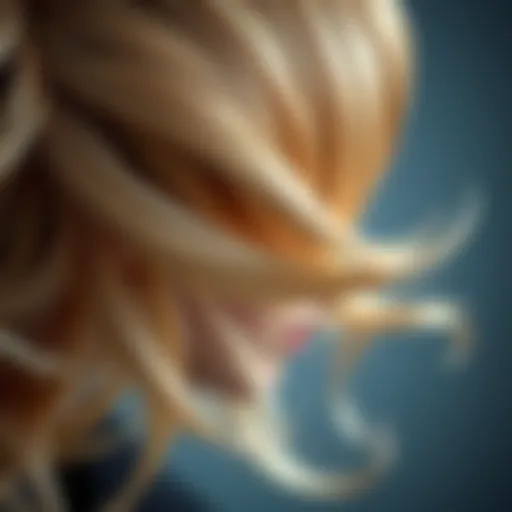Exploring Artificial Flowers in Design and Art
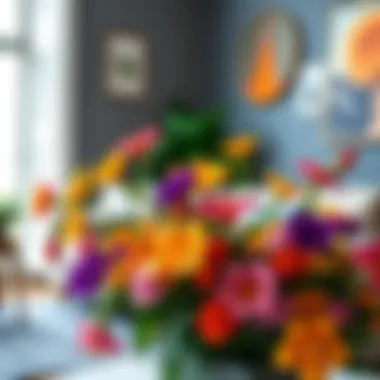
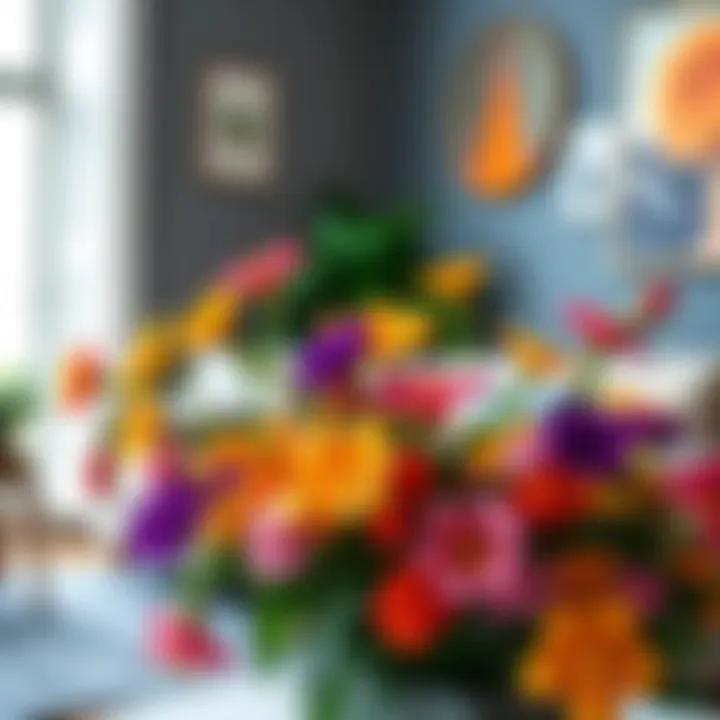
Intro
Artificial flowers have gained a prominent foothold in both interior design and personal aesthetics over recent years. Beyond mere decorations, these crafted blooms actually hold emotional resonance and significant artistic value. As we journey through the world of artificial flora, we'll explore their role in contemporary fashion, their intricate design elements, and, importantly, their alignment with eco-friendly practices. With technological advances shaping their production, artificial flowers now boast a realism that often outshines their natural counterparts. Let's delve deeper into the captivating cosmos of these decor elements and uncover what makes them an excellent choice for fashion enthusiasts and boutique proprietors alike.
Fashion Trends
In this fast-paced world of ever-changing aesthetics, artificial flowers have carved out a niche that blends seamlessly with various fashion trends.
Emerging Styles
Recent seasons have seen a surge in styles that reflect a blend of bohemian flair and minimalist design. Think of oversized arrangements in muted tones juxtaposed against sleek backgrounds. This approach allows the vibrancy of the artificial flowers to truly pop. Retail spaces are applying this trend creatively, integrating artificial blooms into window displays and product layouts.
Another emerging style involves whimsical and eccentric arrangements. Bouquets in mismatched colors and shapes create a playful atmosphere, ideal for settings targeting younger demographics. Undoubtedly, they add a fresh perspective to traditional floral designs and invite both curiosity and joy.
Seasonal Must-Haves
As every season unfolds, so do the trends in artificial flowers. Spring often brings soft pastels reminiscent of cherry blossoms, while summer favors bold and lively colors that mimic tropical blooms. A timely incorporation of seasonal must-haves entices customers and keeps offerings relevant.
- Winter: Think frosty whites and deep reds to celebrate the festive spirit.
- Autumn: Rich hues like burnt orange and maroon resonate with the nostalgia of fall.
To capitalize on these trends, boutique owners must curate their collections carefully, attending to shifts in color palettes that resonate with their audience.
Fabric and Sustainability
As consumers increasingly prioritize sustainability, the choice of materials in producing artificial flowers has come under scrutiny. This aspect holds significance not only for the flowers themselves but also for the broader fashion landscape.
Eco-Friendly Materials
Sustainable practices have become a critical consideration in the design and fabrication of artificial flowers. Many designers now source materials that minimize environmental impact, using recycled fabrics, biodegradable components, and non-toxic dyes. Brands that embrace these principles often appeal to environmentally-conscious consumers, paving the way for responsible indulgence in floral decor.
Impact of Textile Production
The textile industry is notorious for its environmental footprint, making it imperative to assess the ramifications of producing artificial flowers. By understanding the life cycle of textiles—from resource extraction to end-of-life—designers can better align their practices with sustainability goals. This knowledge empowers boutique owners to make informed decisions about their inventory, ensuring they contribute positively to the environment.
"With the right approach, artificial flowers can capture the essence of nature while promoting sustainable practices. Every choice counts!"
In summary, artificial flowers are no longer seen as mere substitutes for the real thing; they are considered a dynamic element of contemporary fashion and eco-friendly design. As we further dissect this floral universe, our admiration for their craftsmanship will only deepen.
Intro to Artificial Flowers
Artificial flowers, often underestimated, embody a fascinating synthesis of artistry and function. They represent more than mere imitations of nature; they encapsulate creativity, emotional depth, and modern sustainability practices. The importance of artificial flowers in contemporary design cannot be overstated. They serve various purposes ranging from aesthetic enhancement to emotional connection, fostering a space where beauty intersects with innovation.
As we explore this topic further, it becomes evident that artificial flowers are not simply decorative objects. Their versatility stretches across different settings, making them ideal for various demographics. For fashion enthusiasts and boutique owners, understanding the nuances of these creations can significantly influence business strategies, event planning, and even personal home decor choices.
In this section, we will delve into the definition and history of artificial flowers, alongside their cultural significance, illustrating how these crafted beauties have evolved and the roles they play in society today.
Definition and History
Artificial flowers are crafted representations of real blooms, made from diverse materials such as silk, plastic, and even biodegradable substances. They first appeared in ancient civilizations, with the Chinese being among the pioneers in creating delicately crafted flowers from paper and fabric. These historical pieces were often associated with significant events such as weddings or funerals, representing emotions and intentions.
Through the ages, the methods employed in producing artificial flowers evolved. In the Victorian era, intricate techniques flourished, with artisans meticulously fashioning flowers to adorn clothing or home decor. Fast forward to the 20th century, and synthetic materials took center stage, making production more affordable and accessible than ever. Today, advanced technologies allow for the precise replication of flowers, capturing even the fine details of petals.
Cultural Significance
The significance of artificial flowers can’t merely be tied to their aesthetic value. They carry profound symbolic meanings across cultures. For instance, in some countries, artificial flowers are used to decorate altars and shrines during religious ceremonies, signifying purity and respect. In Japan, the art of making artificial flowers, known as shakyo, reflects seasonal changes and promotes the beauty of nature amidst urbanization.
Moreover, these crafted wonders are associated with emotional connections. They often serve as lasting memorials, representing love and remembrance. The persistence of artificial flowers remains a testament to their ability to encapsulate human emotions.
"Artificial flowers not only beautify spaces but also have roots in rich traditions and cultures, illuminating their importance in contemporary decor."
With such a deep history and rich cultural significance, artificial flowers offer insights into human creativity and emotional expression. Understanding this context enriches our perspective as we continue to navigate their role in various domains, from fashion to interior decor.
The Art and Craftsmanship of Artificial Flowers
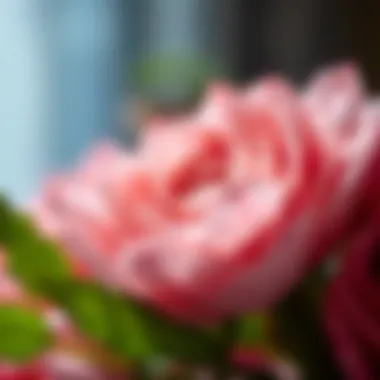
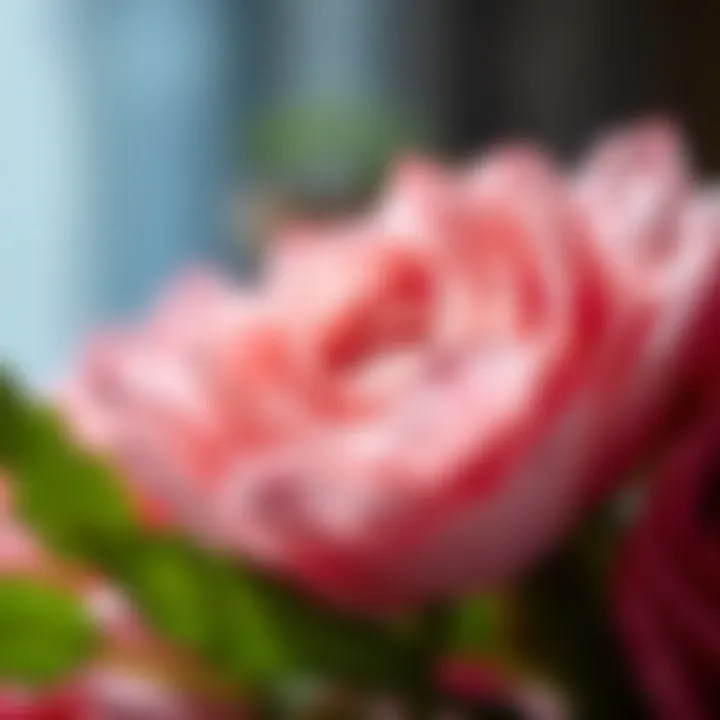
The artistry involved in the creation of artificial flowers is often overlooked, yet it plays a fundamental role in shaping their aesthetic and functional value. The blend of creativity and technical skills required to craft these beauties is what elevates artificial flowers from mere decor to pieces of art that resonate with many viewers. Understanding the nuances of this craftsmanship not only enhances appreciation but illuminates the intricate process that defines the world of artificial floral design.
Materials Used
Creating lifelike artificial flowers involves a diverse array of materials. The choice of substances is crucial, as they directly impact the final appearance and durability of the flowers.
- Silk: Often considered the premium choice, silk offers a softness and sheen that mimic actual petals closely. It’s light, elegant, yet can be quite pricey compared to other materials.
- Polyester: A more affordable substitute, polyester provides resistance to fading and easy care, while still looking relatively realistic.
- Plastic: Commonly used due to its versatility, plastic can be molded into various shapes and textures. While it lacks the elegance of silk, many modern options are designed to resemble real flowers more closely.
- Foam: This lightweight material is often used for flowers that require a soft, pillowy appearance. It’s also malleable, allowing for intricate designs.
- Wire and Tape: Essential for structuring the flowers, wire gives stability, while floral tape helps in creating realistic stems and arrangements.
Each material carries its own benefits and drawbacks. For instance, using silk necessitates careful handling to avoid wear, whereas plastic might offer durability but can sometimes appear less lifelike. Selecting the right materials essentially lays the groundwork for the artistry that follows.
Techniques in Production
The production of artificial flowers is as much an art as it is a science, with techniques that have evolved significantly over years. Some prominent methods used today include:
- Handcrafting: Skilled artisans often handcraft flowers, allowing for personalized touches and a unique finish that factory-produced flowers may lack. Artisans work meticulously to ensure each petal and leaf captures the essence of the real thing.
- Molding: In this technique, artists create detailed molds that can replicate intricate petal structures. Once the mold is set, materials like polymer clay can be pressed into it, resulting in durable yet delicate-looking flowers.
- Printing: Digital printing technology has advanced to the point that it can replicate realistic textures and colors on synthetic fabrics. This method allows for customization and efficiency, especially for larger production runs.
- Assembling: After the individual parts are created—like petals, leaves, and stems—they are assembled into finished products. This can involve intricate wiring and arrangement to create lifelike clusters or bouquets.
Understanding these techniques reveals the labor-intensive processes behind creating what many perceive as simple decor. It emphasizes the skill level and dedication incumbant in producing artificial flowers that not only look realistic but also serve various purposes in decor, fashion, and emotional expression.
"Artificial flowers are not just substitutes for the real thing; they are expressions of artistry and innovation, capable of evoking feelings similar to their living counterparts."
The craftsmanship behind artificial flowers showcases human ingenuity at its best, reflecting a blend of tradition and modernity that continues to flourish in today’s design landscape.
The Role of Technology in Artificial Flower Design
The intersection of technology and artificial flower design has reshaped the industry in remarkable ways. In today's fast-paced world, it’s not just about creating something pretty; technology has become the backbone that supports innovation, efficiency, and sustainable practices. This section focuses on how advancements in manufacturing and digital design innovations are revolutionizing the way these floral creations are made and perceived.
Advancements in Manufacturing
Over the last couple of decades, the manufacturing process for artificial flowers has evolved tremendously. Traditional methods that relied on manual labor have given way to sophisticated machinery and techniques that not only speed up production but also improve quality. For instance, automated cutting machines can now slice fabric with precision, ensuring that petals and leaves maintain a consistent shape and size.
- Injection Molding: This technique has emerged as a go-to for mass-producing flower components. It allows manufacturers to create intricate designs that capture the beauty of real flowers without the tedious manual effort.
- 3D Printing: One of the most exciting developments has been the rise of 3D printing technology. Designers can create detailed floral elements and customize them easily. This technology opens up a realm of creativity, enabling innovative designs that were previously hard to achieve. For example, artists can print complex petal shapes that mimic the textures of nature with incredible fidelity.
Furthermore, technology enhances the durability of products. Many modern artificial flowers are made using high-quality, UV-resistant materials that can withstand various environmental conditions. This is a significant step forward for outdoor applications, where flowers must endure harsh sunlight and rain without fading.
Digital Design Innovations
The role of digital technology in the design phase cannot be understated. Software like Adobe Illustrator and CAD (Computer-Aided Design) programs are now staples among designers, allowing them to create virtual models of their floral designs before a single petal is cut. This digital phase offers numerous benefits:
- Enhanced Visualization: By creating 3D models, designers can visualize how their work will appear in real-life settings, leading to better aesthetic choices.
- Collaboration and Feedback: Digital tools facilitate collaboration among teams, enabling instant feedback and iterations. This collaborative nature means that designers can integrate various input, help refine ideas quickly, and enhance the overall quality of the final product.
"Technology is a creative force that bridges the gap between imagination and reality in artificial flower design."
Moreover, online platforms and social media allow designers to showcase their work, reach a wider audience, and receive immediate reactions from potential customers. This accessibility means that trends can shift rapidly, forcing designers to stay ahead of the curve, innovate continually, and adapt their strategies accordingly.
Artificial Flowers and Sustainability
Artificial flowers, once merely seen as quaint items in home decor or whimsical gifts, now stand at a pivotal intersection between beauty and sustainability. This section sheds light on the importance of sustainability relating to artificial flowers, underscoring the positive impacts and challenges that accompany their use. More than cosmetic enhancements, these creations hold potential for environmentally-conscious consumers, contributing significantly to broader themes of eco-friendliness and sustainable living.
Environmental Impact
Artificial flowers offer a unique perspective on environmental considerations in design and decor. Unlike their natural counterparts, these blooms don't wilt and die. They won’t be discarded after a short lifespan, avoiding frequent replacements that contribute to plant waste. However, the materials used to craft artificial flowers can sometimes raise eyebrows. Many are made from plastics or other synthetic materials, often resulting in a lesser reputation in the eco-sustainability arena.
That said, the lifespan of an artificial flower far exceeds that of a real flower. If maintained well, they can last for many years, dramatically reducing the frequency of replacements. This longevity makes them an increasingly popular choice for environmentally-conscious decorators. Consider, for example, the long-lasting arrangements that can serve for seasons or even years, eliminating the need for continuous purchases of fresh florals.
Moreover, creative recycling efforts are in play. Many manufacturers are beginning to explore plant-based plastics or recyclable components for their artificial flowers, which are moves in the right direction. As modern consumers educate themselves, they increasingly seek products that reduce waste and promote sustainability. With ongoing advancements, there is potential to shift perceptions about these synthetic beauties entirely.
"Sustainability isn't just a trend; it’s a rethinking of our relationship with products we bring into our lives. Artificial flowers can embody this philosophy beautifully."
Eco-Friendly Practices
A closer examination reveals that various eco-friendly practices are becoming paramount in the artificial flower industry. With growing awareness about environmental degradation, innovations are now aimed at aligning artificial flower design with sustainable methodologies. This means manufacturers are not only focused on aesthetics but also on reducing the carbon footprint associated with production.
- Material Sourcing: More brands are choosing recycled or sustainably sourced materials for their floral creations. For instance, some companies utilize recycled plastics derived from bottles and packaging.
- Sustainable Manufacturing: Innovative techniques in production incorporate less energy-intensive processes. For example, digital printing leaves minimal waste compared to traditional methods, which often generate excess material.
- Local Production: There’s a trend towards supporting local artisans and manufacturers to minimize transportation emissions. As people prefer to invest in local products, many businesses are finding ways to maintain quality without the heavy environmental cost.
- Recycling Initiatives: Brands like Afloral have taken steps to encourage customers to recycle their artificial flowers at the end of life. This initiative not only fosters good practices but also promotes a circular economy within the industry.
- Ecosystem Contributions: Lastly, while artificial flowers do not support pollinators like bees, some brands are also promoting initiatives that contribute to real flower planting or conservation as a way to counterbalance their products’ environmental impact.
Exploring Aesthetics: How Artificial Flowers Enhance Spaces
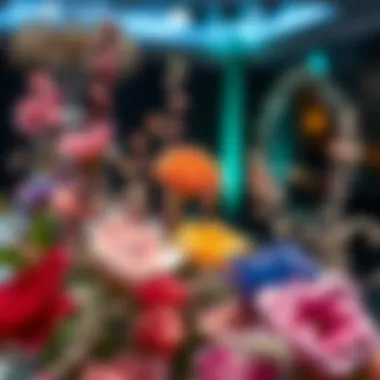
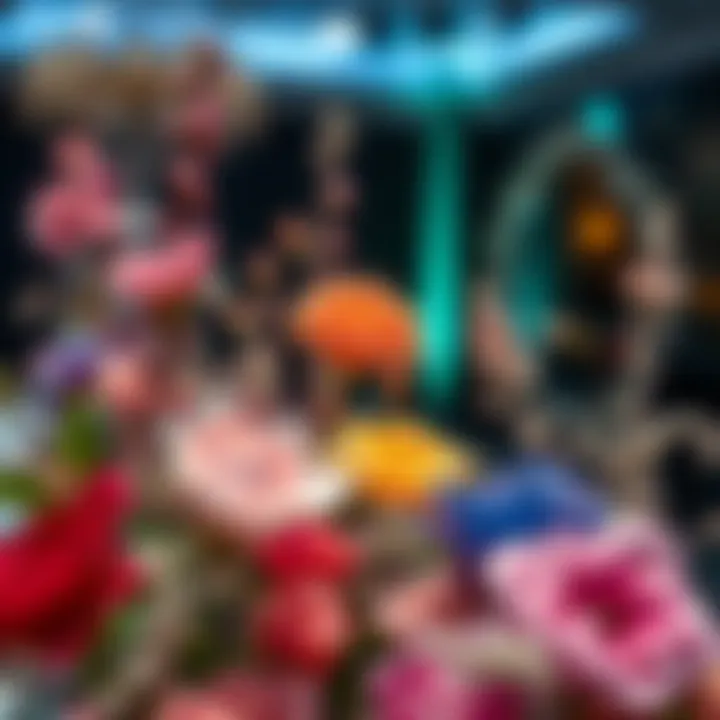
Artificial flowers have carved out a solid niche in the design landscape, showcasing their unmatched ability to add charm and vibrancy to various environments. Understanding their aesthetic potential is crucial, especially for fashion enthusiasts and boutique owners who seek to cultivate an inviting atmosphere. These floral creations go beyond mere decoration; they function as emotional enhancers, eliciting joy and comfort within spaces.
In essence, the beauty of artificial flowers lies in their versatility. They bring a splash of color to both indoor corners and outdoor gardens. As consumers increasingly gravitate toward sustainable options, the allure of these innovative blooms continues to grow. Their reliable nature and consistent appearance make them an ideal choice, regardless of the setting.
Indoor and Outdoor Applications
Artificial flowers find themselves thriving in a plethora of settings, serving as compelling accents to indoor décor as well as being resilient companions for outdoor gardens. Inside, they enhance spaces ranging from cozy living rooms to upscale boutiques. For instance, imagine entering a high-end shop with carefully arranged blooms in a display case. Not only do these flowers elevate visual appeal, but they also create a pleasant olfactory experience by simulating freshness with scents incorporated into their design.
Outdoor spaces, too, revel in the charm offered by artificial flowers. Patrons of gardens and terraces often use them to maintain a picturesque environment without the upkeep that real flowers demand. Drape some artificial roses around a patio, and suddenly an ordinary setting transforms into a romantic nook. The weather-resistant materials employed in manufacturing ensure these flowers maintain their splendor regardless of seasons or elements.
"Artificial flowers provide the convenience of beauty without the fuss of upkeep, appealing to those yearning for aesthetic enhancements that are both stunning and practical."
Role in Event Decor
When it comes to special occasions, artificial flowers take center stage, acting as vital elements in event décor. From weddings to corporate gatherings, maintaining a cohesive aesthetic can be challenging. Here, artificial blooms serve as versatile allies in crafting unforgettable experiences. Their ability to fit diverse themes—from rustic, vintage vibes with sunflowers to elegant settings featuring orchids—ensures that no matter the vision, there’s a perfect floral match.
Moreover, they hold the significant advantage of being economically friendly. Real flowers, while stunning, can rack up costs quickly, especially when one needs specific arrangements or extensive quantities. Artificial alternatives stand resilient in this regard, preserving beauty long after the last guests have departed. Additionally, their reusability means savings for future events, an attractive proposition for both individuals and event planners alike.
The Emotional Resonance of Artificial Flowers
Artificial flowers, often underestimated in their emotional capacity, can evoke a spectrum of feelings and memories that resonate deeply with individuals. This section explores the intricate connections between artificial flowers and emotions, covering their symbolism in gifting and their impact on mood and ambiance. Such an understanding helps to illuminate their significance beyond mere decoration, influencing choices in fashion and decor for the discerning audience.
Symbolism in Gifting
Gifting an artificial flower may seem trivial, yet it carries distinct emotional weight. Unlike their natural counterparts, artificial blooms can symbolize lasting love and remembrance. A vibrant silk rose or a delicate peony made from fine materials can express sentiments that need not wilt with time. They stand as tokens of affection, often representing cherished memories or relationships that endure.
Consider the following reasons why artificial flowers are a profound choice for gifting:
- Longevity: Unlike real flowers, which fade within days, these crafted delights can be enjoyed indefinitely, serving as a lasting reminder of special occasions.
- Personalization: With a variety of colors and styles, the recipient can find beauty that reflects their personality or fits their home decor, making the gift truly special.
- Allergy-Friendly: For sensitive individuals, artificial flowers represent a way to enjoy floral beauty without triggering allergies, making them an inclusive gift option.
As such, gifting artificial flowers can serve not just as an act of kindness but as a meaningful expression of emotions that live on, allowing relationships to flourish even when life's challenges arise everywhere.
Impact on Mood and Ambiance
Artificial flowers wield considerable influence over mood and atmosphere alike. The colors and arrangements chosen can profoundly affect one’s feelings, creating a welcoming ambiance in spaces both large and small. The vibrancy of a crafted arrangement can uplift even the dreariest of rooms, transforming a mundane environment into a sanctuary of beauty and calm.
Research shows that color psychology plays an important role in how we feel. For instance:
- Warm colors like reds and oranges often create feelings of warmth and comfort, ideal for spaces meant for gathering and conversation.
- Cool colors such as blues and greens can evoke tranquility, potentially making them better suited for relaxation areas like bedrooms or libraries.
Furthermore, the positive impact of artificial flowers in commercial spaces, such as boutiques or salons, can be hard to ignore. A well-placed arrangement can engender an inviting ambiance, encouraging customers to linger and engage.
"The aesthetic appeal of artificial flowers can be a game changer, creating an ambiance that attracts clients and enhances emotional well-being for both customer and owner."
Artificial Flowers in Fashion
The realm of artificial flowers in fashion is not one to overlook. Their significance bridges the gap between artistic expression and wearability, transforming garments and accessories into eye-catching statements. As fashion evolves, incorporating these florals grants designers an opportunity to experiment, creating pieces that resonate emotionally as well as aesthetically. The beauty of artificial blooms lies in their versatility; they can be manipulated to fit various styles, from haute couture to everyday wear.
Utilization in Apparel Design
Artificial flowers have found their way into apparel design in a multitude of ways. Designers often embellish garments with intricate floral appliqués, engaging the eye and enhancing the piece’s overall visual narrative. For instance, a flowing dress adorned with delicate silk roses can evoke a sense of romance and nostalgia, appealing to sentiments that resonate with many consumers.
- Textile Manipulation: The integration of artificial flowers can also reshape garment construction. Designers like Alexander McQueen and Dolce & Gabbana have showcased elaborate floral designs that merge the lines between fashion and art.
- Seasonal Appeal: During spring and summer, artificial flowers can accentuate light fabrics and bright colors, aligning with seasonal themes while maintaining durability beyond mere blooms.
These applications not only enhance visual depth but also encourage sustainable practices, as artificial flowers can be reused across various outfits and seasons, reducing waste in the fast-fashion industry.
Influence on Accessory Trends
The use of artificial flowers in accessories has gained considerable traction, breathing new life into fashion statements. From runway looks to everyday ensembles, these whimsical elements often dictate trends and consumer choice.
- Headpieces and Hair Accessories: Floral crowns have become synonymous with festivals and summer weddings, allowing wearers to channel a bohemian spirit without the ecological footprint of real flowers.
- Bags and Shoes: Designers are increasingly using artificial blooms in handbag and shoe adornments. Brands such as Gucci and Givenchy have creatively incorporated florals, elevating their products while maintaining a contemporary edge.
"Artificial flowers allow for creativity without the seasonal constraints of nature. They embody timeless beauty that can be revisited time and again."
In this manner, artificial flowers in fashion are not just decorative; they are a lasting representation of innovation, reflecting advancements in design while capturing the emotional and artistic essence of modern fashion.
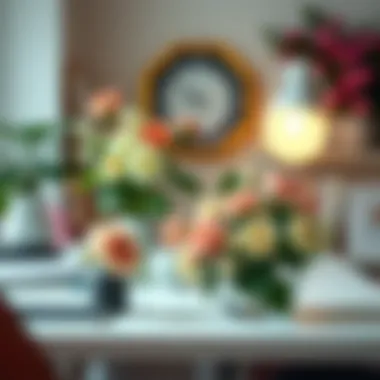
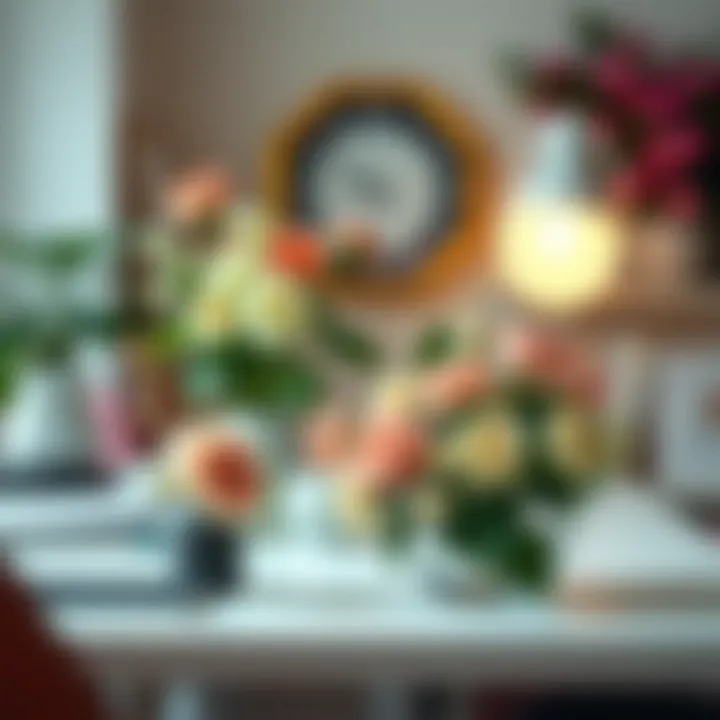
Case Studies: Notable Designers and Their Work
Exploring the world of artificial flowers opens a window into an artistic universe where creativity and innovation blend seamlessly. This section serves as a spotlight on trailblazers and their unique contributions to artificial floral design. Analyzing the work of notable designers is crucial for understanding the evolution of these captivating creations, enabling insights into how they continue to redefine contemporary art and decor.
Innovators in Artificial Floral Design
In the realm of artificial flowers, several designers have made extraordinary strides that call for attention. These pioneers have transformed the mundane into the magnificent.
One noteworthy figure is Martha Stewart, whose influence extends beyond just home decor. Through her curated line of artificial flowers, she underscores the idea that beauty need not be temporary. Her pieces often invoke authentic floral aesthetics, skillfully combining materials that mimic the delicate nuances of nature. This approach aids in convincing even the most discerning customers that artificial options are just as appealing as their fresh counterparts.
Another influential designer, Joanna Gaines, approaches floral design with a focus on simplicity and timelessness. Her use of soft colors and rustic charm not only makes her flowers suitable for various interior styles but also resonates with a laid-back aesthetic that many seek. Gaines emphasizes sustainability, encouraging consumers to choose faux flowers that minimize waste, thereby shifting consumer perception towards appreciating well-crafted artificial blooms.
A global name, Kanzashi Takumi, revives traditional Japanese techniques in her floral arrangements. This designer employs intricate folding methods with fabrics to create blossoms that showcase both artistry and cultural heritage. With her work, the emphasis lies not only on artistry but also on honoring the past—a significant consideration in an industry that thrives on both innovation and tradition.
These innovators each embody distinct philosophies, showcasing how artificial flowers can be both beautiful and infused with a deeper meaning.
Impact on Contemporary Art
Artificial flowers are no longer mere decorative items; they have evolved into significant components of contemporary art. Artists and designers integrate these materials into their work, offering fresh perspectives on beauty, life, and impermanence. By merging artificial blooms with other artistic mediums, they challenge viewers to rethink the superficial distinctions between real and fabricated.
Art installation, such as those by Kara Walker, uses artificial flowers to invoke conversations surrounding race, identity, and femininity. Walker’s work plays with contrasting elements, pushing viewers to explore deeper societal issues through the lens of floral aesthetics. This method showcases the versatility of artificial flowers within fine art, turning them into genuine instruments for dialogue.
Likewise, Holly Alford, known for her vibrant floral sculptures, utilizes synthetic flowers to create mesmerizing installations that elicit emotions ranging from joy to melancholy. Alford’s pieces often play with scale and presentation, reflecting on nature's role in our lives in a modern context. By doing this, she compels the audience to reflect on the relationship between artificial constructs and reality.
"Artificial flowers, when placed thoughtfully in art and design, can evoke a sense of nostalgia and contemplation."
These case studies illustrate that artificial flowers extend beyond horticultural representations; they embody cultural narratives, artistic expression, and sustainability. As these craftsmen and artists continue to innovate and inspire, the future of artificial floral design looks exceedingly bright.
Challenges and Critiques within the Industry
Understanding the challenges faced within the artificial flower industry is crucial for both creators and consumers. As the market for these decorative pieces continues to expand, it is essential to address not just the opportunities but also the critiques that accompany their production and acceptance. This section serves to illuminate the shifting perceptions and the realities surrounding artificial flowers, alongside dissecting market trends and consumer behavior that shape the industry.
Perceptions vs. Reality
Artificial flowers have long faced a certain stigma. Many perceive them as mere cheap imitations of nature, lacking the charm and sensory appeal of live blooms. Some people argue that they are an inferior choice, tarnished by a notion that they are less ‘authentic’ than fresh flowers. Yet, as the craftsmanship grows more sophisticated, a disconnect often emerges between public perception and reality.
Real Talk: More often than not, people are unaware of the incredible detail and innovation behind many modern artificial flowers. Contemporary designs incorporate materials such as durable silk, advanced plastics, and even eco-friendly substances that mimic the texture and appearance of real petals. In many cases, the artificial version presents a greater longevity and ease of maintenance, making it a practical choice for consumers looking for vibrant decor that won’t wilt.
"The utilitarian nature of artificial flowers meets the aesthetic demands of today’s fast-paced, environmentally-conscious world."
As consumers become savvier, they begin to appreciate the artistry and technical skill involved in designing high-quality artificial blooms. This recognition is reshaping opinions, suggesting that perceptions are slowly aligning more closely with reality. The challenge lies in changing those lingering preconceived notions where they still dominate.
Market Trends and Consumer Behavior
The dynamics of consumer behavior are slowly evolving when it comes to artificial flowers. With sustainability on everyone’s mind, many are purchasing decorative items that uphold their values—hence the rise in demand for eco-friendly materials in artificial flower production.
Some trends worth noting include:
- Increased Customization: Many consumers now seek bespoke arrangements that fit their exact aesthetic needs, leading to a surge in businesses offering personalized floral designs.
- Social Media Influence: Platforms like Instagram and Pinterest have become breeding grounds for inspiration, showcasing artificial flowers in stunning interiors and events, which tends to sway public opinion positively.
- Hybrid Choices: As innovations in materials and design continue, a blend of real and artificial arrangements is becoming popular. This compromise offers a fresh take on traditional floral decor, channeling both authenticity and practicality.
In summary, as consumers shift toward a more informed and considerate approach to their purchases, the artificial flower industry is steadily carving a niche that marries aesthetic appeal with practical benefits. The key moving forward will be to continue addressing the challenges surrounding perception while adapting to the trends that reflect changing consumer desires and values.
Future Directions: The Evolution of Artificial Flowers
The future of artificial flowers is blossoming with potential, intertwining artistry and innovation at unprecedented levels. As we delve deeper into this subject, we recognize the inherent importance of understanding where artificial flowers are heading. With aesthetic preferences evolving and technological advancements taking center stage, this section serves to illuminate how these floral imitations might transform in design, function, and cultural relevance. Acknowledging the trajectory of artificial flowers helps designers and consumers alike make informed decisions that marry beauty, sustainability, and modernity.
Predictions for Technology and Design
The landscape of artificial flower design is rapidly changing, thanks in no small part to technology. 3D printing stands as a prime example of innovation's role in the near future of this industry. Unlike traditional methods, where materials are limited, 3D printing allows for a plethora of possibilities. This tech enables designers to create intricate patterns and lifelike textures that can mimic real flowers far more closely than before, leading to enhanced visual appeal.
Also, advancements in smart materials hold promise. These materials can change in response to their environment, adjusting colors or even scents based on factors such as light or humidity. Imagine an artificial rose that emits a subtle fragrance when it detects a change in room temperature – now that would be something to see at a wedding or event!
Aside from the technical side, digital design tools are evolving rapidly, offering designers new ways to visualize and manipulate their creations. These platforms allow for real-time collaboration between artists, resulting in more refined products that cater to specific consumer desires.
Integration with Fashion and Interior Design
The integration of artificial flowers into fashion and interior design is not merely a trend but a movement shifting how we view and use floral decor. In fashion, the addition of artificial flowers to garments and accessories has found renewed enthusiasm. Designers are employing them as unique embellishments, drawing attention and adding layers of meaning to their collections. For instance, the use of fabric roses on jackets or belts elevates a simple outfit, giving it depth and personality, much like how a monogram does but with a more organic touch.
In terms of interior design, artificial flowers are revolutionizing the way we think about home decor. They offer a low-maintenance, yet visually engaging alternative, allowing individuals to infuse nature into their living spaces without the need for constant upkeep. Designers increasingly feature artificial flora in setting up ambiances in homes, offices, and public venues. Hence, whether it's a chic coffee shop boasting a burst of vibrant blooms on the walls or a luxurious hotel lobby adorned with elegant, lifelike arrangements, artificial flowers are becoming the go-to solution for creating inviting atmospheres.
"The integration of artificial flowers into our culture represents a fusion of art and nature, reshaping aesthetic principles in various fields."





